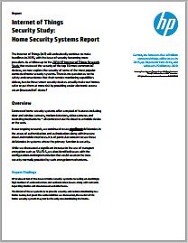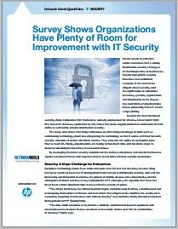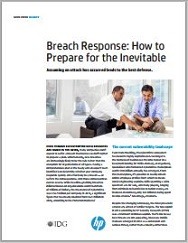
Internet of Things Security Study: Home Security Systems Report
Home security and remote monitoring systems are a major application of the Internet of Things (IoT). Most include sensors, motion detectors, video cameras, and recorders—all connected via the cloud to a mobile device or the web. But are they—and IoT applications in general—secure from hackers? This research study uses HP Fortify on Demand to test 10 popular home security systems.

An Unlikely Partnership? Application Security and Development
Agile development organizations often see application security considerations as impediments to the rapid release cycles they strive for. But releasing software with vulnerabilities opens the door to hackers and puts the entire business at risk. How do you develop an application security program that protects the business without impacting time to market?

Survey Shows Organizations Have Plenty of Room for Improvement With IT Security
most organizations lack confidence in the ability of their security defenses to keep them safe. In fact, more than half said 100% security is a pipe dream.

Advanced Threat Detection and Remediation: Why It’s Needed
In 2014 detected cyber security incidents rose sharply to 42.8 million, and the financial impact of cyber crime increased by 34 percent. An effective cyber security program has never been more important. And an effective program must not only attempt to detect and block incoming threats, it must detect and neutralize successful attacks before the damage is done.

2015 Cyber Risk Report
We’re making it easy for hackers. New technologies like mobile, Big Data, and the Internet of Things expand the attack surface and bring new technologies they can exploit. In addition, weaknesses in code that is decades old and common problems like server misconfiguration, weak passwords, and poor coding practices open doors that should have been closed long ago.

Behind The Mask: The Changing Face Of Hacking
Headlines featuring large-scale cyber breaches at Target, Home Depot, Sony Pictures, and others have taught us one thing—no-one is safe. But who are the hackers who are able to pull off such huge attacks against sophisticated targets, including the U.S. Government? And how do they do it?

Outrunning The Bear: 5 Critical Ways To Take A More Collaborative Approach To IT Security
Studies show the average time to resolve a security breach once detected is more than 45 days, and companies lose more than $1.6 million during that time. The obstacles to faster response include lack of resources and an inability to effectively communicate and collaborate among the multiple teams and tools larger enterprises rely on for protection.

Breach Response: How To Prepare For The Inevitable
To avoid being breached, you have to get it right every single time. To breach you, hackers only have to get it right once. Experts advise breaches are inevitable. And according to Ponemon Institute, the average time to resolve a cyber attack is 45 days, with an average cost of $35,647 per day. The key to minimizing damage is preparation.


